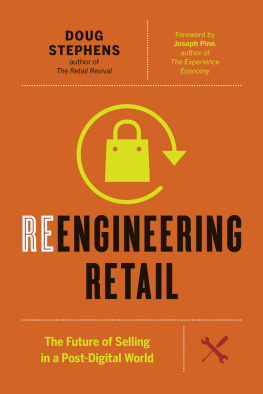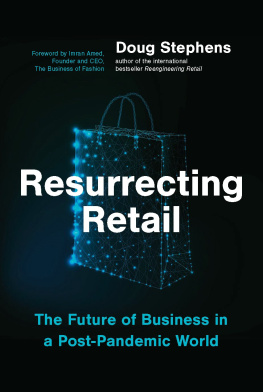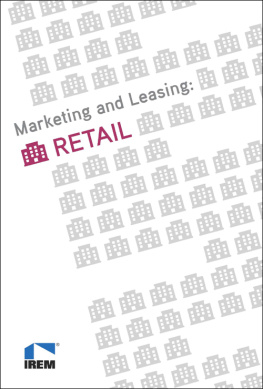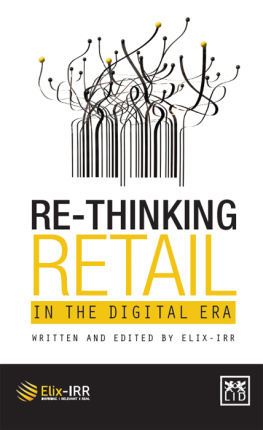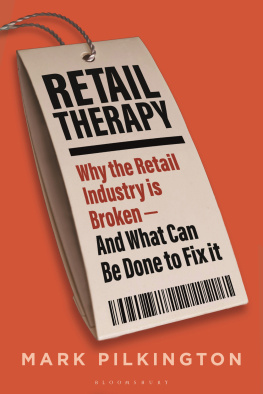TWO GREAT FORCES flow across the economic landscape.
The first is the commoditization of goods and services, for people increasingly want to buy them at the greatest possible convenience and the lowest possible price. The rise of the Internet as a platform for purchasing exacerbates this force. People can instantly compare prices from one vendor to another, which tends to push them down to the lowest possible price. Or forget the price comparisonjust go to Amazon.com where youre assured a great (if not the lowest) price and even greater convenience: one click, boom, done, your purchase is heading to your home!
The second great force is the shift into the Experience Economy. Goods and services are no longer enough; people increasingly desire experiencesmemorable events that engage each individual in an inherently personal way. We see this fundamental shift in the very fabric of the economy in the rise of theme parks, theme restaurants, boutique hotels, and of course experiential retail, where cafs, pop-up stores, showrooms, climbing walls, yoga studios, and countless other experiences engage consumers in retail stores. Surprisingly, manufacturers are making most of these innovations, not retailers themselves!
And naturally these forces intertwine. Consumers want goods and services to be commoditized so they can spend their hard-earned money, and their harder-earned time, on the experiences they value so much more highly.
Retail expert Doug Stephens lays out the stark choice retailers have in the face of these forces: create innovative experiences or be commoditized. Providing a tour of what is being done now and what is possible in the future, Doug lays out a roadmap that you can follow in determining what the store of the future should befor you. In doing so, he hits on some points near and dear to my own heart.
Dougs exactly right in saying that we need to understand that The Store Is Media, or as I like to put it, the experience is the marketing. The best way to generate demand for your retail offerings is through an experience so engaging that consumers cant help but spend time in your place, give you their attention, and buy your offerings as a result.
Doug beautifully defines remarkable experiences as those that are engaging, unique, personalized, surprising, and repeatable. How can you design and stage a store experience that fits those five adjectives? Read here to figure that out.
That third adjective, personalized, is incredibly important, as Doug highlights with the possibilities for mass-customizing offerings within (and without) your retail venues, particularly thanks to the rise of 3D printing. Even if that particular digital technology doesnt make sense for your business, do recognize that experiences are inherently personal. They actually happen inside people in reaction to the events and places you stage for them. Therefore, the more personal you make your experiences, and your retail offerings, the more engaging and memorable you will be.
And best of all, Doug encourages you to conquer your fear of all the various digital technologies that so often keep consumers out of physical stores, and he shows you how to embrace them to enhance your in-store experience. You need not dread online buying once you understand that Reality will now and forevermore provide the richest of experiencesespecially since that richness can be enhanced through technologies that enable you to fuse the real and the virtual.
Let Reengineering Retail be your guide in todays increasingly turbulent world of retail, for again you must make your choice: stage retail experiences or be commoditized.
B. JOSEPH PINE II
Dellwood, Minnesota
Co-founder, Strategic Horizons LLP
Co-author, The Experience Economy and Infinite Possibility: Creating Customer Value on the Digital Frontier
SOFTWARE EATS RETAIL. This was technology investor Marc Andreessens morbid epitaph for the retail industry in a January 2013 interview. Andreessen, the co-founder of the web browser Netscape Navigator, is also one of Silicon Valleys most influential investment gurus and one-half of the eponymous venture capital powerhouse Andreessen Horowitz. His company has interests in an array of Internet technology firms, including Facebook, Airbnb, Twitter and Pinterest, to name only a few. He also sits on the boards of Facebook and Hewlett-Packard and has spent decades as a technology practitioner, innovator, investor and advisor, triangulating the future of the web and betting big on what he sees coming next. Moreover, he has a reputation for doing so with alarming acuity. Consequently, when he clears his throat to speak, people tend to sit up and listen, hoping to catch even a momentary glimpse into his deadly accurate crystal ball.
Not one to mince words, he summed up his industry outlook by saying, Retail guys are going to go out of business and
Mic drop.
The interview had barely pixelated on Twitter before sparking a firestorm of debate. Industry analysts, pundits and even retail executives themselves began offering up ammunition on both sides of the argument.
Some felt that Andreessens comments were utter bullshit and not much more than the bluster of an investor with an obvious and vested financial axe to grind on behalf of the technology companies he was so deeply involved with. They pointed to the impossibility of a retail world without retail guys, as Andreessen called them. They decried pure-play online retail as a failed business model being propped up by endless streams of venture capital that, in the end, would collapse under its own weight.
Others took a very different view, falling in line behind him and pointing to the disastrous impact of technology on other verticals, such as the brick-and-mortar travel industryan industry that had been all but laid to waste by online travel options. They pointed to the downfall of businesses like Blockbuster, which once held almost 30 percent market share in the video rental market and yet was wiped off the face of the Earth by Netflix and video on demand in little more than a decade. They called out the retail industry incumbents for their failure to meet the pace of progress around them.
To their point, within a little more than two hundred years weve witnessed the following technological innovations become things we simply take for granted.
- the lightbulb
- the telegraph
- the electromagnet
- petroleum
- the telephone
- the vacuum tube
- semiconductors
- penicillin
- the radio
- the electron
- quantum physics
- the airplane
- television
- the transistor
- the discovery of dna
- the integrated circuit
- the Internet
- microprocessors
- the mobile phone
- the smartphone
- the quantum computer
Technological progress and its impact on humanity has been staggering. How many of us could possibly imagine a world without these things? And yet, in the face of all of this, the concept of retail and how its carried out hasnt changed much at all. The way we go to the store, browse products and pay for those products is essentially the same today as it was two hundred years ago. Sure, we dont use a horse and buggy to deliver goods anymore and cash registers dont have bells, but the core economic model for how retailers buy products and sell those products to consumers is the same in almost every respect as it was in the mid-1800s. Those in Andreessens camp were right to wonder, how could retail possibly be so out of sync with progress on most other fronts?

